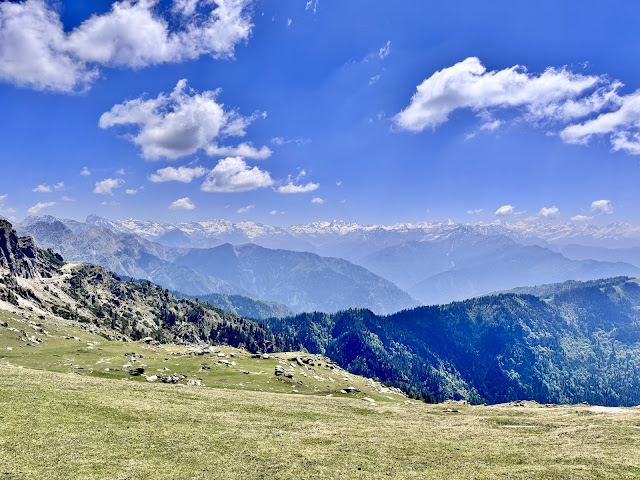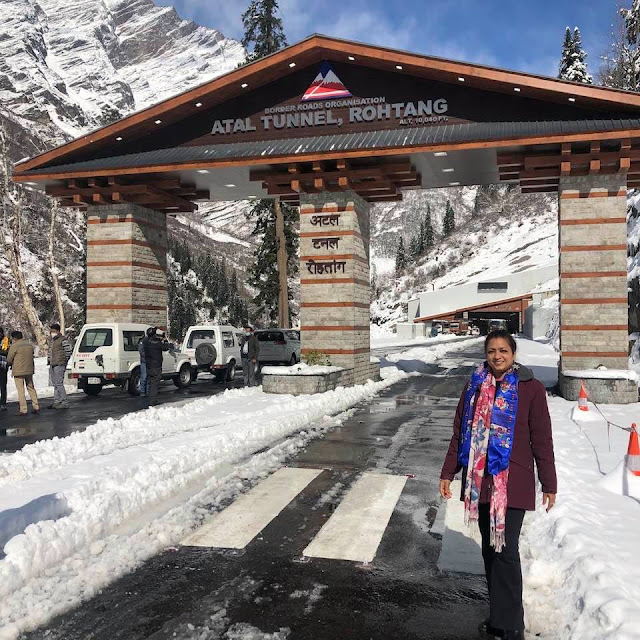DODRA and KAWAR - Mysterious Himachal
Himachal also has many such places and at the top of the list is – DODRA - KAWAR – probably the remotest and one of the most backward areas of Himachal. Till 2009 it was approachable only on foot (three days trek to the nearest road head) and still gets cut off for 3-4 months a year due to heavy snow fall on highlands. It mainly remained cut off because the road could not be constructed as the local ‘Deity’ did not give permission for it till 2006. Administratively also it was just a tehsil and became a sub division recently. Its a tri-junction of the state of Uttrakhand and Rohru and Sangla in Himachal. The confluence is evident in its language, dress and culture.
Ever since I came to this state, I had heard about this far
off land (a dreaded posting for the government servants) – and it always evoked
curiosity. Last month my husband decided to visit it and I tagged along. The
bonus was that we would also get to cross the ‘Gateway to Dodra - the Chanshal
Pass’ - the only way to reach it by road - said to be one of the most beautiful
passes of Himachal.
Historically not much is known about it; though it is said
that Dodra-Kwar was given as a dowry to Raja of Bushar by the Raja of Tehri.
But when and to whom is not known or recorded. The valley falls directly on the
traditional Sangla – Ruppin Pass – Naitwar trail that links the Baspa
Valley of Himachal to Tons Valley of Uttarakhand (a trail used by IAS probationers from Mussoorie very often) - but it still remains
elusive as no historical records for this area were preserved or maybe never
written; information is only available in folklores.
Now the question is - why did people settle in such a remote
area?
There are no answer to this question except a probable
explanation – the nomads with sheep used to venture into this valley from Uttarakhand side during summers for want of good fodder. They also built basic wooden
shelters for themselves and their herds. In the late 17th century,
the Gurkhas started spreading their wings at the expense of rulers of
Uttaranchal and Himachal. Raids and wars started becoming frequent and some people
started taking shelter in Ruppin valley to safeguard themselves and their cattle
wealth. And probably started staying on. When Gorkhas reached this valley in
early 18th cent they got badly defeated by the locals. The people of
this area still feel a strong connect with Uttarakhand and before the
construction of the road it was its main support and still is in many ways.
So - where are Dodra and Kawar and how does one travel there?
These are two villages of the Shimla district in the Ruppin valley and one has to travel via Rohru and Chanshal to reach there. As soon as one nears Rohru the scenery starts to get enchanting because of the beautiful meandering Pabbar River and apple orchards. We stopped at all tourists’ attractions on way– Khara Patthar, Giri Ganga, Mandali forest rest house and stayed the night at Sandasu – next to Pabbar
Next day we started early to enjoy the Chanshal Pass. As
soon as we crossed Larot, the road started to get bumpy; but the scenery better.
The 50 km climb to the 3750m high pass is formidable. There were trees on the way, which I had never seen before – the Mohru trees (these are lopped every three
years for fodder and hence acquire an interesting shape) and the Pink
Rhododendron (State flower). There were Cedar and Birch also and different shrubs.
Almost non existent road from Larot to Chanchal 
The Mohru Trees -lopped every three years for fodder for sheep - and they take an interesting shape
Slowly the trees started to disappear and meadows appeared with wild flowers - yellow and purple –with green leaves and also medicinal plants. As we approached Chanshal, I realised that indeed it is one of the most beautiful passes of Himachal with slopes ideal for skiing (though not feasible because of its accessibility). I was totally mesmerised by the 360 degree view of meandering meadows and snow-clad mountains at a distance. No doubt it’s a much desired destination for Bikers and Hikers. A must visit for whoever can plan
Though my heart wanted to stay more at Chanshal (dil ka kya
kareein) but our destination was Dodra Kwar. So we started ahead with many cars
accompanying us. It was the first time a Chief Secretary of Himachal was
travelling to Dodra by road, hence a celebration for the valley.
The first distant look of Kwar and then the cluster of Dodra village brought one thought in my mind – ‘Frozen in Time’. The Kwar village is bigger (cluster of four villages) than Dodra but the style is the same. They both are 22 km apart from each other with Rupin River flowing between them. The settlements looked well settled – actually much bigger than my expectations. The houses and temples - made of stone and wood - are very traditional, very old, and very beautiful with local wood carvings – and totally merge with their surroundings. The style is known as Kathkuni in Himachal. The ground floor is reserved for animals and stocking of wood and top floors for humans. This keeps the entire house warm during winters. They are constructed close to each other giving a sense of security.
Rupin River
Kawar Village
My heart was completely charmed to see the locals, who had gathered in their traditional dresses to greet us. Dresses fully prepared by them from making cloth to stitching them. I also got to wear their Jhudki and Lokhuti (traditional dress made of hand made tweed) and dance with them in their local temple. Devta culture is the dominant force here and all major decisions are through them. Also, there are strong hints of culture of Jaadu-Tona in the valley.
At Dodra
At Kawar
Wearing Judki and Lokhuti
I was happy to see that our lunch was all traditional dishes made of magical millets, organic vegetables, local ghee and honey served with lots of affection and pride. Amarnath (chollai) is a staple crop and diet along with rajma, buckwheat, barley, peas, bathu, mandwa, ogla, chavra, local rice and maize, and phapra (used for distilling local liquor). Meat (especially dried meat) is a delicacy though many in the valley are becoming vegetarians now due to the influence of Beas Dera (religious organisation) in Punjab.
 Amarnath being cultivated - the magical millet
Amarnath being cultivated - the magical millet 
With apple crop - Pic courtesy Internet
My time in Ruppin valley was short, but I could still feel a sense of peace in their day to day living with their surroundings. Despite the road being constructed and less snowfall – the people of Dodra-Kwar do not travel much and are mostly happy with their valley. And why not after all what do most humans want in life – peace, good health, happy relations, closeness to nature and simple lifestyle – and they have it all.
The area is remote for sure but I will not call it mysterious as people are simple and lead a satisfied life. Though, higher education and advanced medical facilities are still an issue and are only available outside the valley. It is indeed backwards but mainly because of its geographical isolation for so long though the governemnt is trying to bring in many facilities now. But what is noticeable and progressive about them is their approach towards life – they are in sync with nature, are particular about their traditions and respect their relationships.
If one wants to experience and learn lessons in how to live life organically - then Dodra-Kwar should be the destination.




































Gives such a beautiful description of the wonderful land!
ReplyDeleteSuch a wonderful piece penned with immense love and adulation 💫
ReplyDeleteVery informative!
ReplyDeleteBeautiful pictures with a well descriptive script.Very informative.Kudos
ReplyDeleteLovely explanation of place and culture along with mesmerizing pictures...😍
ReplyDeleteBeautiful pics with lots of information about the valley
ReplyDeleteThanks
ReplyDeleteAnother masterpiece on less known customs and traditions of rural populace living in backward areas of Himachal Pradesh.
ReplyDeleteThank you 🙏 for sharing this information, Madam
Nice
ReplyDeleteLoved going through the article
This is so interesting, and comprehensive. C8vers everything. Seems it was really a unique trip..thanks for sharing
ReplyDeleteWhat a vivid description.Thanks Anurita Saxena for sharing your rich experience.
ReplyDeleteWonderful blog mam
ReplyDeleteLovely description and pictures of enchanting places. One doesn’t come to know of such places and their lifestyles.
ReplyDeleteI remember there used to be District Gazettes in the British period. Your Himachal wide travels can easily be converted into authentic and updated district gazettes 👍
Another informative and explicative piece of writing on Dodra Kwar that has come out excellently through your pictorial blog with all nuts and bolts in terms of historical description,cultural aspects and societal praxises.A magnetizing Chanshal Pass is another attraction for tourists especially for bikers and trekkers that offers an arresting view.If one is an ardent lover of nature ,then the area of Dodra Kwar is a perfect destination where soaring mountains,picturesque hamlets, swift streams and fruit laden orchards make one’s ramble quite fascinating and memorable.If one wishes to be away from the maddening crowd for sometime or if one becomes bromidic and feels fed up with the humdrum routine of life ,then such places are worth visiting.One really finds oneself in communion with nature by feeling a current of placidity and a flow of ataraxia .That’s why Himachal Pradesh is called as Dev Bhumi.
ReplyDeleteBy going through your elucidation ma’am,I am indeed reminded of my own peregrination to these unsullied villages which I had undertaken in the year 2021.
Very nice blog with beautiful pictures.
ReplyDeleteYour writing style is so engaging.I was completely drawn in to the write-up.
ReplyDeleteI wish I was there.
Again a very informative article with eloquent pictures...anything you do is with full heart and fervor...keep traveling and introduce me to exotic places...❣️
ReplyDelete